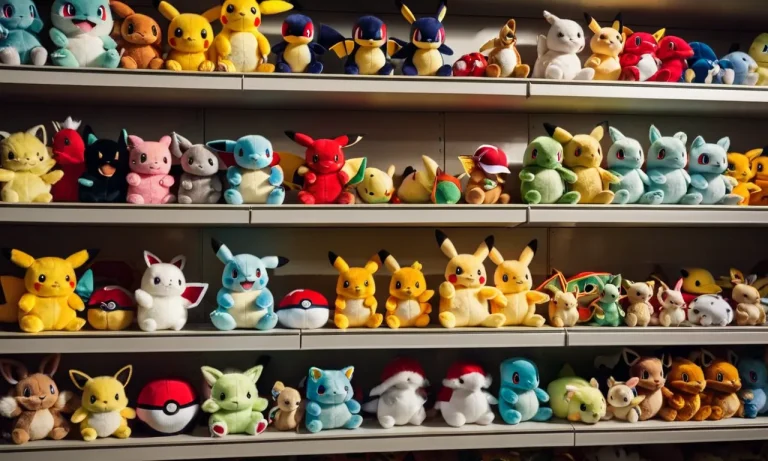If your child has come home from school or camp with a case of head lice, you may be worried about the infestation spreading to their beloved stuffed animals. Lice can survive for a surprisingly long time on fabric and soft surfaces, so proper treatment of infested items is vital.
If you’re short on time, here’s the quick answer: Lice can live for 1-2 days on stuffed animals without a human host. To be safe, isolate stuffed animals for 10-14 days during lice treatment or wash and dry them on the hottest settings.
Do Lice Stay Alive on Stuffed Toys?
Lice Require Human Blood to Survive
Head lice are tiny wingless insects that live and feed on blood from the human scalp. They cannot fly or jump, but crawl from head to head through close personal contact. Without a human host, head lice will perish within 1-2 days without a blood meal (CDC).
For head lice to survive, they need to feed on human blood several times a day. Lice have specially adapted claws to cling onto human hair while they feed. If lice fall or crawl onto furniture, stuffed animals, clothing, or bedding, they lose access to the blood meals they need to live (Mayo Clinic).
Without blood meals, lice will grow weaker and eventually die from starvation.
Stuffed Toys Lack Nutrients But Offer Temporary Refuge
While stuffed toys and pillows do not contain nutrients to sustain head lice, their soft fibers provide a temporary place for lice to hide and rest (Terminix). Lice may accidentally crawl or fall onto stuffed animals if a child has an active head lice infestation and sleeps with stuffed toys.
However, without access to human blood, lice cannot survive longer than 1-2 days.
The CDC states that the risk of getting head lice from inanimate objects like furniture, clothing, and bedding is very small. Head lice survive less than 48 hours without feeding, and their eggs cannot hatch without blood meals.
So even if lice or eggs are accidentally deposited onto fabrics and furniture, they will die quickly without a human host.
| Where Lice Can Live | Where Lice Cannot Survive |
|
|
The bottom line is that while lice may temporarily crawl or fall onto stuffed toys, they cannot live there. Stuffed animals do not contain blood meals, so lice will die from starvation within a day or two (WebMD).
The best way to deal with lice on stuffed toys is to machine wash and dry the toy on high heat, or to bag it for 2 weeks until any lice or eggs have died off. With vigilance and proper treatment, lice can be cleared from the home environment.
How Long Can Lice Live on Stuffed Animals?
1-2 Days Maximum Without Feeding
Head lice thrive on human blood and generally cannot survive longer than 1-2 days without a blood meal from their human host (isn’t that gross? 🤢). Once on a stuffed animal or other inanimate object, head lice will quickly start to dehydrate and die off.
According to experts, the maximum head lice can survive without feeding is around 1-2 days. After that, they will perish from lack of sustenance.
Some key factors related to head lice survival away from a human host include:
- Temperature – Lice prefer temperatures close to human body temperature. In a colder stuffed animal environment, they may expire sooner.
- Humidity – Drier environments also speed up dehydration and death.
- Fabric type – Some materials like faux fur may retain heat better slightly prolonging life.
Temperature and Fabric Type Also Matter
As covered briefly above, temperature and stuffed animal fabric can impact how long lice may survive. To recap:
| Factor | Impact on Lice Survival |
|---|---|
| Temperature | Warmer stuffed animals near 98°F can extend life vs. colder environments |
| Fabric Type | Faux fur retains more body heat compared to cotton, wool, etc. |
But even with slightly more favorable conditions, research shows head lice almost invariably die off within 1-2 days without feeding. So while temperature and fabric play a small role, the lack of a human blood meal is by far the greatest threat to lice survival on stuffed animals over time.
The bottom line is that while lice can crawl onto stuffed animals if in close head-to-head contact with an infected person, they likely won’t last more than 24-48 hours at most. So quarantining stuffed animals for 2-3 days should eliminate any potential lingering head lice (CDC).
We hope this info helps reassure anyone facing a lice battle that their beloved plush pals will be A-OK! 👍
What’s the Best Way to Kill Lice on Stuffed Toys?
Isolating Toys During Treatment
Isolating stuffed animals by sealing them in plastic bags for 2 weeks is an effective way to kill lice during treatment. Lice can only survive 1-2 days without feeding on blood, so keeping toys isolated for 14 days ensures any lice will die off (1).
Be sure bags are completely sealed so lice cannot escape if the toy was infested. This hands-off approach saves the hassle of cleaning each toy. An added bonus – it only costs the price of a few plastic bags! Just stash bagged toys out of reach from kids until the 2 weeks are up.
Washing and Drying
Vigorously washing and then drying stuffed toys on the hottest setting possible can eliminate lice lingering on the toys’ surfaces. Use hot water above 130°F and laundry detergent when washing. The American Academy of Pediatrics recommends washing with hot water and drying for at least 20 minutes on high heat (2).
Hands should be washed after handling toys pre-washing. Pay special attention to folds, creases, and any fur when washing. After washing and drying is complete, seal toys in a clean plastic bag for 2 weeks to ensure any remaining eggs have died.
Using Heat Tools
Heat tools like portable steamers and hair dryers are handy for targeting the heat treatment on stuffed animals. Steaming toys on the highest setting helps kill lice through high heat. Pay special attention to seams, folds in fabric, and fur when steaming.
Similarly, use a hair dryer on the highest and hottest setting to blast hot air on toys for 10 minutes straight, which should kill lice (3). Make sure to move the dryer around to cover all toy surfaces. Spot treat problem areas with extra heat. Finish by sealing toys in plastic bags for 2 weeks.
Vacuuming
Thorough vacuuming can physically remove lice from stuffed animal surfaces. Use a hose attachment to meticulously vacuum all sides, crevices, folds, and fibers on toys. Afterwards, sealed toys in bags for 2 weeks to ensure vacuuming removed all lice.
Vacuuming first before washing may also remove debris that could trap lice during a wash cycle. When done vacuuming, remove the vacuum bag/canister and discard it outside immediately so lice cannot escape back into the home. Vigorously wash hands after handling infested toys and vacuuming.
Preventing Lice From Infesting Stuffed Animals
Inspect Children and Stuffed Toys Frequently
One of the best ways to stop lice from spreading to stuffed animals is to catch an infestation early. The American Academy of Pediatrics recommends checking your child’s head at least once a week if there is an outbreak at school.
You should also inspect stuffed animals, pillows, hats, and other items children have close contact with frequently. Look closely at the seams and surfaces of the toys where lice or nits (lice eggs) may be hiding.
Store Stuffed Animals Properly
When stuffed toys aren’t being played with, storing them properly can help keep lice away:
- Keep toys in plastic bins or bags instead of having them openly displayed in bedrooms.
- Store hats, helmets, and other headgear in separate containers away from stuffed toys.
- Wash stuffed animal covers and bags frequently to remove any lice, nits, or residue.
Educate Children About Not Sharing Hats, Helmets etc.
Kids love to share their favorite stuffed animals and toys with friends. While it’s great for children to share, they also need to understand lice prevention:
- Explain that stuffed animals can help spread lice just like hats or helmets shared between friends.
- Ask them to avoid head-to-head contact activities like puppy piles.
- No sharing combs, pillows, headphones or any other items that touch the head.
With some care and prevention, you can still allow children to play with stuffed animals without fear of recurring lice infestations. Be diligent about inspections, limit sharing, and educate kids on prevention.
When to Discard a Stuffed Animal Due to Lice
If Repeated Treatments Fail
Getting rid of lice on stuffed animals can be challenging. You may need to treat the toy multiple times over several weeks before the infestation is fully gone. Here’s when experts recommend discarding a beloved stuffed animal due to repeated lice treatments:
- You’ve treated the toy at least 3 times over a 6-week period according to product directions, but live lice keep reappearing. At this point, the stuffed animal likely cannot be salvaged.
- The stuffed animal shows signs of damage from repeated pesticide exposure and treatment. This includes bald spots, staining, or other wear and tear that cannot be reversed.
- Your child has an emotional attachment to the toy and is distressed about repeated treatments. Throwing it away may be better for their mental health.
According to clinical studies, only an estimated 5-10% of lice cases persist after two careful treatment cycles. If you are still finding live lice after 3 or more thorough treatments, the toy is probably a lost cause. As difficult as it may be, discarding it permanently prevents reinfestation.
When Visibly Soiled or Damaged
Stuffed animals that are visibly dirty or damaged due to a lice infestation should also be discarded. Here are some signs it’s time to throw out the toy:
- There is visible dirt, debris, or stains that cannot be cleaned. Lice thrive on dirt and oils.
- The fabric is very worn, has bald patches, or has begun to unravel. The toy cannot be effectively treated.
- The stuffing is coming out. Eggs and lice can hide deep inside.
- There is a strong, unpleasant odor that persists after washing.
- It was exposed to lice treatments not approved for stuffed toys.
Letting children keep such as toy is unwise. Even after intense cleaning efforts, the lice, eggs, and waste material trapped in fabric remain infectious. A visibly damaged stuffed animal simply cannot be disinfected adequately.
| 5-10% | Percentage of lice cases still persisting after 2 careful treatments |
| 3 times | Minimum repeated treatments before discarding a stuffed animal |
Saying goodbye to a special stuffed friend is never fun. But letting go of lice-infested stuffed animals is vital to getting rid of the infestation for good. If treatments repeatedly fail or the toy is too dirty or damaged, it is best for your family’s health to discard it.
Conclusion
While lice can only live for about one to two days on stuffed animals without feeding, proper treatment is still essential to prevent reinfestation. By isolating stuffed toys during treatment, washing or using heat tools, and taking preventative steps moving forward, you can rest assured knowing your child’s favorite snuggly friends are lice-free.
With some diligence during treatment and extra care going forward, your child shouldn’t have to lose their special stuffed pals due to a louse infestation.







